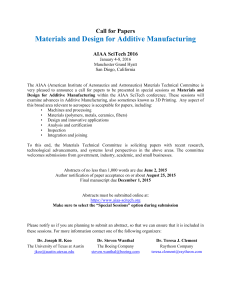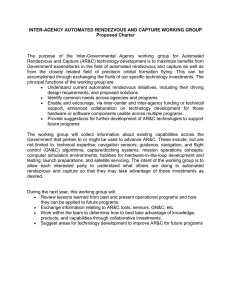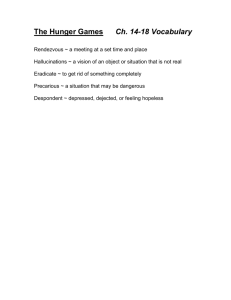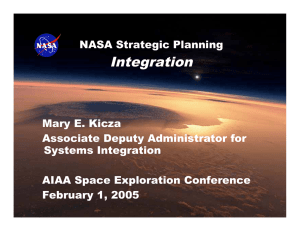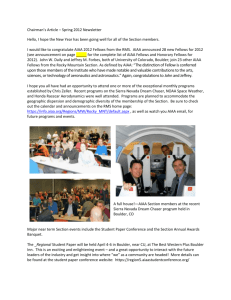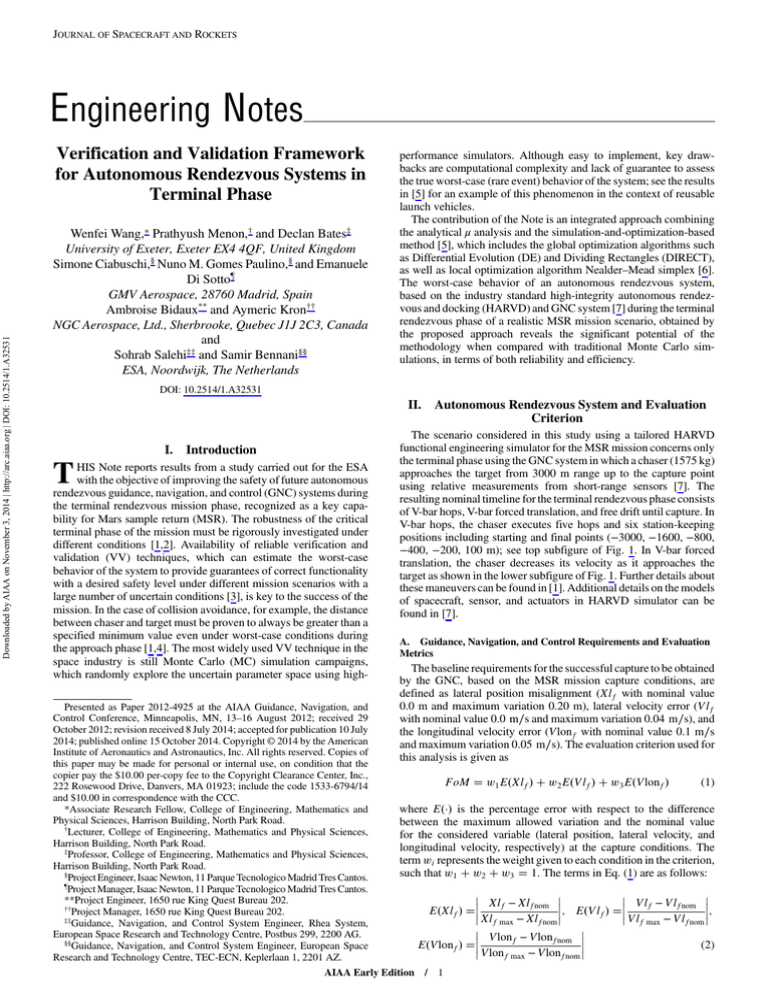
JOURNAL OF SPACECRAFT AND ROCKETS
Engineering Notes
Downloaded by AIAA on November 3, 2014 | http://arc.aiaa.org | DOI: 10.2514/1.A32531
Verification and Validation Framework
for Autonomous Rendezvous Systems in
Terminal Phase
Wenfei Wang,∗ Prathyush Menon,† and Declan Bates‡
University of Exeter, Exeter EX4 4QF, United Kingdom
Simone Ciabuschi,§ Nuno M. Gomes Paulino,§ and Emanuele
Di Sotto¶
GMV Aerospace, 28760 Madrid, Spain
Ambroise Bidaux** and Aymeric Kron††
NGC Aerospace, Ltd., Sherbrooke, Quebec J1J 2C3, Canada
and
Sohrab Salehi‡‡ and Samir Bennani§§
ESA, Noordwijk, The Netherlands
performance simulators. Although easy to implement, key drawbacks are computational complexity and lack of guarantee to assess
the true worst-case (rare event) behavior of the system; see the results
in [5] for an example of this phenomenon in the context of reusable
launch vehicles.
The contribution of the Note is an integrated approach combining
the analytical μ analysis and the simulation-and-optimization-based
method [5], which includes the global optimization algorithms such
as Differential Evolution (DE) and Dividing Rectangles (DIRECT),
as well as local optimization algorithm Nealder–Mead simplex [6].
The worst-case behavior of an autonomous rendezvous system,
based on the industry standard high-integrity autonomous rendezvous and docking (HARVD) and GNC system [7] during the terminal
rendezvous phase of a realistic MSR mission scenario, obtained by
the proposed approach reveals the significant potential of the
methodology when compared with traditional Monte Carlo simulations, in terms of both reliability and efficiency.
DOI: 10.2514/1.A32531
II.
I.
Introduction
T
HIS Note reports results from a study carried out for the ESA
with the objective of improving the safety of future autonomous
rendezvous guidance, navigation, and control (GNC) systems during
the terminal rendezvous mission phase, recognized as a key capability for Mars sample return (MSR). The robustness of the critical
terminal phase of the mission must be rigorously investigated under
different conditions [1,2]. Availability of reliable verification and
validation (VV) techniques, which can estimate the worst-case
behavior of the system to provide guarantees of correct functionality
with a desired safety level under different mission scenarios with a
large number of uncertain conditions [3], is key to the success of the
mission. In the case of collision avoidance, for example, the distance
between chaser and target must be proven to always be greater than a
specified minimum value even under worst-case conditions during
the approach phase [1,4]. The most widely used VV technique in the
space industry is still Monte Carlo (MC) simulation campaigns,
which randomly explore the uncertain parameter space using high-
Presented as Paper 2012-4925 at the AIAA Guidance, Navigation, and
Control Conference, Minneapolis, MN, 13–16 August 2012; received 29
October 2012; revision received 8 July 2014; accepted for publication 10 July
2014; published online 15 October 2014. Copyright © 2014 by the American
Institute of Aeronautics and Astronautics, Inc. All rights reserved. Copies of
this paper may be made for personal or internal use, on condition that the
copier pay the $10.00 per-copy fee to the Copyright Clearance Center, Inc.,
222 Rosewood Drive, Danvers, MA 01923; include the code 1533-6794/14
and $10.00 in correspondence with the CCC.
*Associate Research Fellow, College of Engineering, Mathematics and
Physical Sciences, Harrison Building, North Park Road.
†
Lecturer, College of Engineering, Mathematics and Physical Sciences,
Harrison Building, North Park Road.
‡
Professor, College of Engineering, Mathematics and Physical Sciences,
Harrison Building, North Park Road.
§
Project Engineer, Isaac Newton, 11 Parque Tecnologico Madrid Tres Cantos.
¶
Project Manager, Isaac Newton, 11 Parque Tecnologico Madrid Tres Cantos.
**Project Engineer, 1650 rue King Quest Bureau 202.
††
Project Manager, 1650 rue King Quest Bureau 202.
‡‡
Guidance, Navigation, and Control System Engineer, Rhea System,
European Space Research and Technology Centre, Postbus 299, 2200 AG.
§§
Guidance, Navigation, and Control System Engineer, European Space
Research and Technology Centre, TEC-ECN, Keplerlaan 1, 2201 AZ.
Autonomous Rendezvous System and Evaluation
Criterion
The scenario considered in this study using a tailored HARVD
functional engineering simulator for the MSR mission concerns only
the terminal phase using the GNC system in which a chaser (1575 kg)
approaches the target from 3000 m range up to the capture point
using relative measurements from short-range sensors [7]. The
resulting nominal timeline for the terminal rendezvous phase consists
of V-bar hops, V-bar forced translation, and free drift until capture. In
V-bar hops, the chaser executes five hops and six station-keeping
positions including starting and final points (−3000, −1600, −800,
−400, −200, 100 m); see top subfigure of Fig. 1. In V-bar forced
translation, the chaser decreases its velocity as it approaches the
target as shown in the lower subfigure of Fig. 1. Further details about
these maneuvers can be found in [1]. Additional details on the models
of spacecraft, sensor, and actuators in HARVD simulator can be
found in [7].
A. Guidance, Navigation, and Control Requirements and Evaluation
Metrics
The baseline requirements for the successful capture to be obtained
by the GNC, based on the MSR mission capture conditions, are
defined as lateral position misalignment (Xlf with nominal value
0.0 m and maximum variation 0.20 m), lateral velocity error (Vlf
with nominal value 0.0 m∕s and maximum variation 0.04 m∕s), and
the longitudinal velocity error (Vlonf with nominal value 0.1 m∕s
and maximum variation 0.05 m∕s). The evaluation criterion used for
this analysis is given as
FoM w1 EXlf w2 EVlf w3 EVlonf (1)
where E· is the percentage error with respect to the difference
between the maximum allowed variation and the nominal value
for the considered variable (lateral position, lateral velocity, and
longitudinal velocity, respectively) at the capture conditions. The
term wi represents the weight given to each condition in the criterion,
such that w1 w2 w3 1. The terms in Eq. (1) are as follows:
Xlf − Xlfnom ;
EXlf Xlf max − Xlfnom Vlonf − Vlonfnom
EVlonf Vlon
− Vlon
AIAA Early Edition / 1
f max
Vlf − Vlfnom ;
EVlf Vlf max − Vlfnom (2)
fnom
Downloaded by AIAA on November 3, 2014 | http://arc.aiaa.org | DOI: 10.2514/1.A32531
2
AIAA Early Edition
/
ENGINEERING NOTES
Fig. 1 Relative path for the terminal phase and decreasing approach velocities during the forced motion phase.
where ·fnom and ·f max are the corresponding nominal and
maximum allowed values at the capture. The worst case maximizes
the figure of merit in Eq. (1), with each wi 1∕3.
B. Uncertain Parameters Considered for Verification and Validation
Two categories of uncertain parameters with a uniform distribution
are considered. The first is the design uncertainties set (DUS), which
represents the 49 uncertain parameters considered during the control
system design phase. The DUS consists of the chaser initial relative
position and velocity (6), absolute knowledge of target initial state
(6), chaser’s mass (1), inertia (9), center of mass (1), Lidar misalignment (2), thrust magnitude bias (8), and thrust misalignment
(16), so that the total of the numbers in parentheses adds up to 49. The
second is the enhanced uncertainties set (EUS), comprised of 118
uncertainties, including the thruster’s location (24), gyroscope
misalignment (3), bias (6) and scale factors (6), star tracker’s misalignment (6), reaction wheels misalignment (8) and chaser flexible
modes such as the solar array’s frequencies (8) and damping factors
(8), and entire DUS (49). This set of uncertainties, in which additional
uncertain parameters are included, particularly those related to the
active sensors and actuators, is considered in order to check the VV
performance beyond the initial design specification. Thus, the EUS
contains additional uncertainties that are not considered during the
design phase.
III.
Integrated Verification and Validation Framework
The proposed strategy steers the optimization-based analysis, in
terms of both the starting point and the search region, by means of μ
analysis results, with the expectation that this will allow faster
convergence in the search for problematic cases. In particular, the
optimization algorithm is initialized at the worst-case parameter
combination derived from the peak of the μ lower bound, while the
uncertain parameter search space is reduced to the area where the
parameters are beyond the limit of guaranteed robustness that the μ
analysis has identified. Algorithm 1 encapsulates the steps involved
in the proposed integrated analysis. In addition, the process to
compute a reduced region and the probabilities associated with
finding a violation case in a subregion based on the sensitivity are
provided in [8]. For the problem defined in this Note, some of the
uncertainties, such as the variation of the initial states of the chaser
spacecraft, cannot be taken into account during the linear fractional
transformation (LFT) modeling and hence in the subsequent μ
analysis [9]. This restriction does not apply to the optimization-based
approach, which can deal with any type of uncertainty in the
simulator.
Based on this fact, denoting the uncertain parameters considered
by LFT∕μ as set S1 and the remaining uncertainties as set S2 , we
attempted to integrate both methods in two different ways:
1) For the uncertain parameters in set S1 , optimization methods
were driven by the redefined bounds and initial values derived from
LFT∕μ, while the other parameters in set S2 were treated as per the
original settings.
2) Uncertain parameters in set S1 were considered as known
parameters with values fixed in the worst cases identified by
LFT∕μ. Only the uncertain parameters in set S2 were then taken
into account by the optimization algorithms. Note that in this
approach the dimension of the search space for the optimization
algorithms was significantly reduced. The μ analysis computation
can be time consuming in certain cases, particularly when linearmatrix-inequality-based analysis is required on a large LFT. However, the μ analysis had fast convergence in all the studies reported in
this Note and was completed in couple of minutes, which is
significantly faster than the time domain simulation.
IV.
Worst-Case Analysis Results
Validation results from a simplified rendezvous scenario are
reported in [10]. Here, the integrated analytical and optimization
approaches given in Algorithm 1 are applied sequentially to validate
AIAA Early Edition
ENGINEERING NOTES
3
Integrated VV framework
1. Define the uncertain set S for the simulator and S1 for the LFT model, where S1 ∪ S2 S. The variation of S1 and S2 are defined with bounds U1 and U2 ,
respectively.
2. Apply the μ analysis using a gain-based method.
a) Initialize the algorithm with two guessed gains W L and W H for μ peaks below and over 1, respectively,
b) while jW H − W L j > ε, where ε is a user-defined threshold.
i. Compute an averaged value W M of W L and W H at each iteration
ii. if the corresponding μpeak < 1.
iii. Let W L W M ,
iv. else
v. Let W H W M .
vi. end
vii. Increase the number of iterations by 1.
c) end
d) Return the worst-case parameter values X1;wc and the redefined bounds U1;wc for S1.
3. Choose the desired optimization algorithm between DIRECT and DE and apply the optimization-based VV,
a) if DIRECT is selected.
i. Set S1 as known uncertain parameters with fixed values X1 X1;wc .
ii. Initialize S2 with random candidate solution and bounds U2 .
iii. Apply DIRECT for a fixed number of iterations.
iv. Return the solution for S2 ,
b) else
i. Initialize S1 with X1;wc and bounds U1 U1;wc and S2 with random candidate and bounds U2 .
ii. Apply DE for a fixed number of iterations.
iii. Return the solution for S (for local algorithm Nelder–Mead, the same procedure can be used as for DE.)
c) end
µ upper and lower bounds
1.5
upper bound
lower bound
µ
1
0.5
0
−4
10
−3
10
−2
−1
0
10
10
frequency (rad/s)
10
1
10
differences between upper and lower bounds
0.15
difference
differences
Downloaded by AIAA on November 3, 2014 | http://arc.aiaa.org | DOI: 10.2514/1.A32531
Algorithm 1
/
0.10
0.05
0
−4
10
−3
10
−2
−1
0
10
10
frequency (rad/s)
10
1
10
Fig. 2 Robust performance analysis results.
the full terminal phase. The μ analysis is performed on the LFT model
of the uncertain six degree of freedom rendezvous system, and the
results are given in Fig. 2. The top graph shows the upper bound and
lower bound of μ with a peak value around 1.2. The bottom graph
presents the difference between the lower bound and upper bound of
μ to provide a measurement of confidence in the computed μ value:
closer bounds implicate a better knowledge of the true μ value. For the
region of interest around the peak, around 0.1 rad∕s, this difference is
below 0.05, and hence the peak value of μ is well characterized by its
bounds at the frequency of the worst case. The results obtained are
then used to derive the redefined search region together with the
initial search point as explained in Sec. III. The upper bound and
Table 1
Method
μ∕local
μ∕DE
μ∕DIRECT
MC
Ewc , %
3.9609 × 104
1.9598 × 105
1.3803 × 105
4.5508 × 104
lower bound peaks, which define the gauranteed performance region
and worst case, are subsequently used to define the scattering area for
the LFT parameters in optimization approaches as discussed in [8,9].
In addition, the initial conditions and thruster misalignment, which
are not taken into account directly in the LFT, are uniformly scattered.
Since the time domain simulation of the full terminal phase
scenario is computationally expensive (each simulation takes almost
40 min), a fixed termination strategy is used for the optimization
algorithms. Thus, the optimization is stopped after a predefined
number of simulations. As shown in Table 1, using this approach, the
local Nelder–Mead simplex algorithm can find the worst case very
fast within the modified search domain, with only 17 simulations
required to get the first violation of the criterion, while 20 out of 200
cases are found to be unsuccessful.
For the population-based algorithm DE, using 150 simulations, 21
of them were found to be unsuccessful after removing the repeated
cases between different iterations. The DIRECTalgorithm converged
more slowly when the dimension of the search space was high. In this
case, the size of the uncertainty set was reduced by setting some
uncertain parameters at their worst-case points found via μ. Through
this strategy, the results show that the DIRECT algorithm can quickly
identify the first violation of the figure of merit at only the seventh
simulation, while overall 12 out of 150 cases are found to be unsuccessful. The relative trajectories of the chaser during the approach
are shown in Fig. 3 for the worst cases found by the local, DE, and
DIRECT methods, respectively. 1000 Monte Carlo simulation runs
identified only seven occurrences of violation, of which the first
violation occurred at the 65th simulation. Moreover, the cost driven
optimization μ∕DE reached a cost value 4.3 times higher than the
Monte Carlo with 15% of the simulation runs. Considering that 1000
runs takes 10–12 days to complete, it is clear that the demonstrated
efficiency of these methods with respect to Monte Carlo results in
striking computational savings. It can be seen that, although for all
cases the hopping phases were performed successfully, the final
locations are far from the reference capture point. These capture
Worst-case results using different integrated methods
EXlf , %
1.1772 × 105
5.8283 × 105
4.0397 × 105
1.3402 × 105
EVlf , %
233.5358
4.9734 × 103
6.5079 × 103
1.9981 × 103
EVlonf , %
872.6166
148.4956
3.6085 × 103
5.0784 × 102
Simulations Violations First violation
200
20
17th
150
21
8th
150
12
7th
1000
7
65th
4
AIAA Early Edition
/
ENGINEERING NOTES
−800
−60
Nominal
µ/local
µ/DE
µ/DIRECT
−600
−40
−20
R−bar [m]
R−bar [m]
−400
−200
0
0
20
40
Nominal
µ/local
µ/DE
µ/DIRECT
60
200
80
400
2000
1000
Fig. 3
0
−1000
V−bar [m]
−2000
−3000
−4000
0
−100
V−bar [m]
−200
−300
Worst-case relative trajectories using μ∕local, μ∕DE, and μ∕DIRECT are compared with the nominal.
failures are due to the GNC system being unable to start the forced
motion or keep the system under control during the forced motion.
Downloaded by AIAA on November 3, 2014 | http://arc.aiaa.org | DOI: 10.2514/1.A32531
100
V.
Conclusions
Two completely different approaches to VV, i.e., linear frequencydomain μ analysis and nonlinear time-domain optimization-based
worst-case analysis, have been combined into an integrated VV
framework in this paper and have been successfully applied to the
industrial standard autonomous rendezvous simulator. A major
advantage of the proposed integrated VV approach is that initial
points and regions in parameter space that are identified by the linear
frequency domain tools such as μ analysis can be used to significantly
improve the performance and convergence rate of the optimizationbased worst-case search. Three different strategies have been
proposed for integrating analytical and optimization-based methods,
and these strategies have shown to provide significant computational
savings.
Acknowledgment
This work was funded by the European Space Agency (ESA)
under contract 21629/08/NL/EK.
References
[1] Fehse, W., Automated Rendezvous and Docking of Spacecraft,
Cambridge Univ. Press, Cambridge, England, U.K., 2003, pp. 362–423.
[2] Kawano, I., Mokuno, M., Kasai, T., and Suzuki, T., “Result and
Evaluation of Autonomous Rendezvous Docking Experiments of ETSVII,” Proceedings of the AIAA Guidance, Navigation and Control
Conference, AIAA Paper 1999-4073, Aug. 1999.
[3] Bateman, A., Balas, G. J., Cooper, J., Aiello, M., and Ward, D.,
“Analytical and Simulation-Based Control Law Robustness Validation
Using CEASAR,” Proceedings of the AIAA Guidance, Navigation and
Control Conference, AIAA Paper 2008-6655, Aug. 2008.
[4] Polites, M. E., “Technology of Automated Rendezvous and Capture in
Space,” Journal of Spacecraft and Rockets, Vol. 36, No. 2, 1999,
pp. 280–291.
doi:10.2514/2.3443
[5] Menon, P. P., Postlethwaite, I., Marcos, A., Bennani, S., and Bates, D.
G., “Robustness Analysis of a Reusable Launch Vehicle Flight Control
Law,” Control Engineering Practice, Vol. 17, No. 7, 2009, pp. 751–765.
doi:10.1016/j.conengprac.2008.12.002
[6] Nelder, J. A., and Mead, R., “A Simplex Method for Function
Minimization,” Computer Journal, Vol. 7, No. 4, 1965, pp. 308–313.
doi:10.1093/comjnl/7.4.308
[7] Strippoli, L., Colmenarejo, P., Modrego, D., Peters, T. V., Le Peuvédic,
C., Guiotto, A., and Salehi, S., “Advanced GNC Solutions for
Rendezvous in Earth and Planetary Exploration Scenarios,” 59th
International Astronautical Congress IAC-08.A3.I.15, Glasgow,
Scotland, 2008, pp. 1793–1807.
[8] Kron, A., Hamel, J. F., Garus, A., and De Lafontaine, J., “μ-Analysis
Based Verification and Validation of Autonomous Satellite Rendezvous
Systems,” Proceedings of the 18th International Federation of
Automatic Control (IFAC) Symposium on Automatic Control in
Aerospace, Nara-ken Shinkokaido, Japan, Sept. 2010, pp. 327–332.
doi:10.3182/20100906-5-JP-2022.00056
[9] Kron, A., Bilodeau, V. S., and Ankersen, F., “Enhanced Linear
Fractional Transformation: A Matlab Toolbox for Space System
Modelling and Controller Analysis and Synthesis,” Proceedings of the
19th International Federation of Automatic Control (IFAC) Symposium
on Automatic Control in Aerospace, Univ. of Wurzburg, Wurzburg,
Germany, Sept. 2013, pp. 512–517.
doi:10.3182/20130902-5-DE-2040.00136
[10] Wang, W., Menon, P. P., Gomes Paulino, N. M., Di Sotto, E., Salehi, S.,
and Bates, D. G., “Worst-Case Analysis of Autonomous Rendezvous
Systems,” Proceedings of the 18th International Federation of
Automatic Control (IFAC) Symposium on Automatic Control in
Aerospace, Nara-ken Shinkokaido, Japan, Sept. 2010, pp. 321–326.
doi:10.3182/20100906-5-JP-2022.00055
D. Geller
Associate Editor

